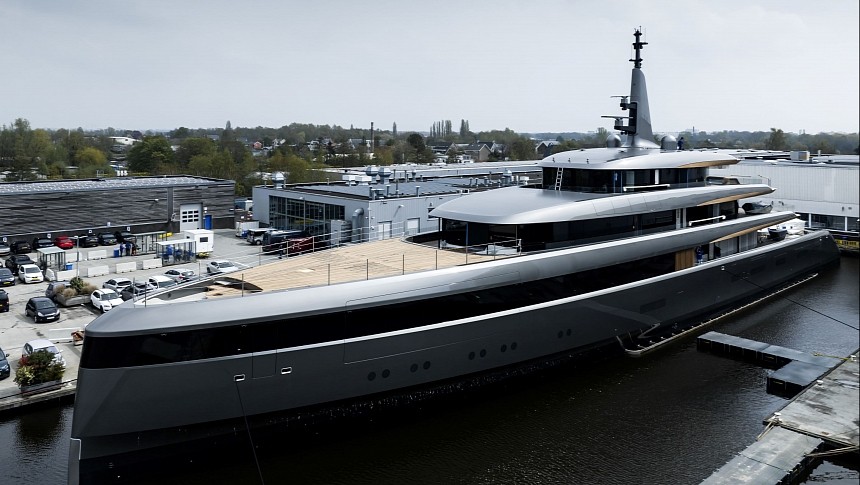When Feadship launched the world's first truly hybrid superyacht, the innovative 274-foot (84-meter) motor yacht Savannah, the Dutch shipbuilder promised to change the yachting experience forever by offering enhanced fuel efficiency and a quieter cruising experience. Now, the company is adding yet another vessel to its lineup of sustainably-focused yachts, further showcasing the innovative approach that has come to define it.
Codenamed Project 710, the shipyard's latest creation is a 275-foot, 6-inch (84.2-meter) hybrid superyacht that came out of the shed in Aalsmeer last week. Boasting a shiny silver hull and futuristic exterior design, the new vessel is said to mark a significant breakthrough for the shipyard and the yachting world as a whole. That’s because it will use Hydrotreated Vegetable Oil, or HVO for short, to run its generators. HVO, a second-generation biodiesel, is a direct replacement for diesel, which means systems, fuel lines, and other components of the yacht won't need any modifications in order to use it.
According to Feadship, which expressed its commitment to building "zero-emissions" superyachts, this biofuel will reduce total carbon-dioxide emissions by up to 90 percent. Project 710 will carry out sea trails with HVO and will be delivered to its owner with the same biofuel in the tanks. Actually, that’s precisely what the owner asked for in the original brief – a yacht that challenges common design and engineering practices.
Moreover, the new project features a single-level engine room, which is unusual for a boat in this size category. Electric drive and steering are accomplished through a pair of electric Veth contra-rotating thrusters designed to maximize efficiency and minimize vibration. This means the vessel forgoes the traditional drive shafts and rudders.
In terms of electrical storage capacity, Project 710 has four and a half times more of that compared to the 2015 Savannah superyacht.
The technical innovations don’t end here, though, as the new yacht is also equipped with new technologies to capture and reutilize waste heat from the mechanical systems, including the Caterpillar gensets and the air-conditioning system’s chiller. The recaptured heat is used to warm up the water coming from faucets, the pool, the AC, engine preheating, and other amenities on board. A separate heat-pump system will draw heat directly from the sea water.
The superyacht’s futuristic exterior look and interior design were the work of the talented British team at RWD in collaboration with MONK Design. Describing the yacht's aesthetic, the yard says its length is "optically stretched by a low profile, horizontal styling features, and very clean shapes flowing aft form a strong bow showcasing strength and seaworthiness."
The fact that it has a single-level engine room means extra interior space for guest accommodation and lounging areas, as well as more flexibility in the layout.
Noteworthy design features include an Aqua Lounge with huge windows below sea level, an asymmetrical atrium staircase that provides access to a lower deck dining saloon, and a terrace view just above sea level. There is also an observation lounge with double-curved glass floor-to-ceiling windows at the bow, while the aft decks have no pillars, giving the impression that they float above the water. Glass balustrades and fully glazed interior spaces aft provide guests unobstructed views of the surrounding seas.
Once delivered to its owner, Project 710 will become the 17th largest yacht in Feadships's portfolio.
According to Feadship, which expressed its commitment to building "zero-emissions" superyachts, this biofuel will reduce total carbon-dioxide emissions by up to 90 percent. Project 710 will carry out sea trails with HVO and will be delivered to its owner with the same biofuel in the tanks. Actually, that’s precisely what the owner asked for in the original brief – a yacht that challenges common design and engineering practices.
Moreover, the new project features a single-level engine room, which is unusual for a boat in this size category. Electric drive and steering are accomplished through a pair of electric Veth contra-rotating thrusters designed to maximize efficiency and minimize vibration. This means the vessel forgoes the traditional drive shafts and rudders.
In terms of electrical storage capacity, Project 710 has four and a half times more of that compared to the 2015 Savannah superyacht.
The technical innovations don’t end here, though, as the new yacht is also equipped with new technologies to capture and reutilize waste heat from the mechanical systems, including the Caterpillar gensets and the air-conditioning system’s chiller. The recaptured heat is used to warm up the water coming from faucets, the pool, the AC, engine preheating, and other amenities on board. A separate heat-pump system will draw heat directly from the sea water.
The superyacht’s futuristic exterior look and interior design were the work of the talented British team at RWD in collaboration with MONK Design. Describing the yacht's aesthetic, the yard says its length is "optically stretched by a low profile, horizontal styling features, and very clean shapes flowing aft form a strong bow showcasing strength and seaworthiness."
The fact that it has a single-level engine room means extra interior space for guest accommodation and lounging areas, as well as more flexibility in the layout.
Noteworthy design features include an Aqua Lounge with huge windows below sea level, an asymmetrical atrium staircase that provides access to a lower deck dining saloon, and a terrace view just above sea level. There is also an observation lounge with double-curved glass floor-to-ceiling windows at the bow, while the aft decks have no pillars, giving the impression that they float above the water. Glass balustrades and fully glazed interior spaces aft provide guests unobstructed views of the surrounding seas.
Once delivered to its owner, Project 710 will become the 17th largest yacht in Feadships's portfolio.










